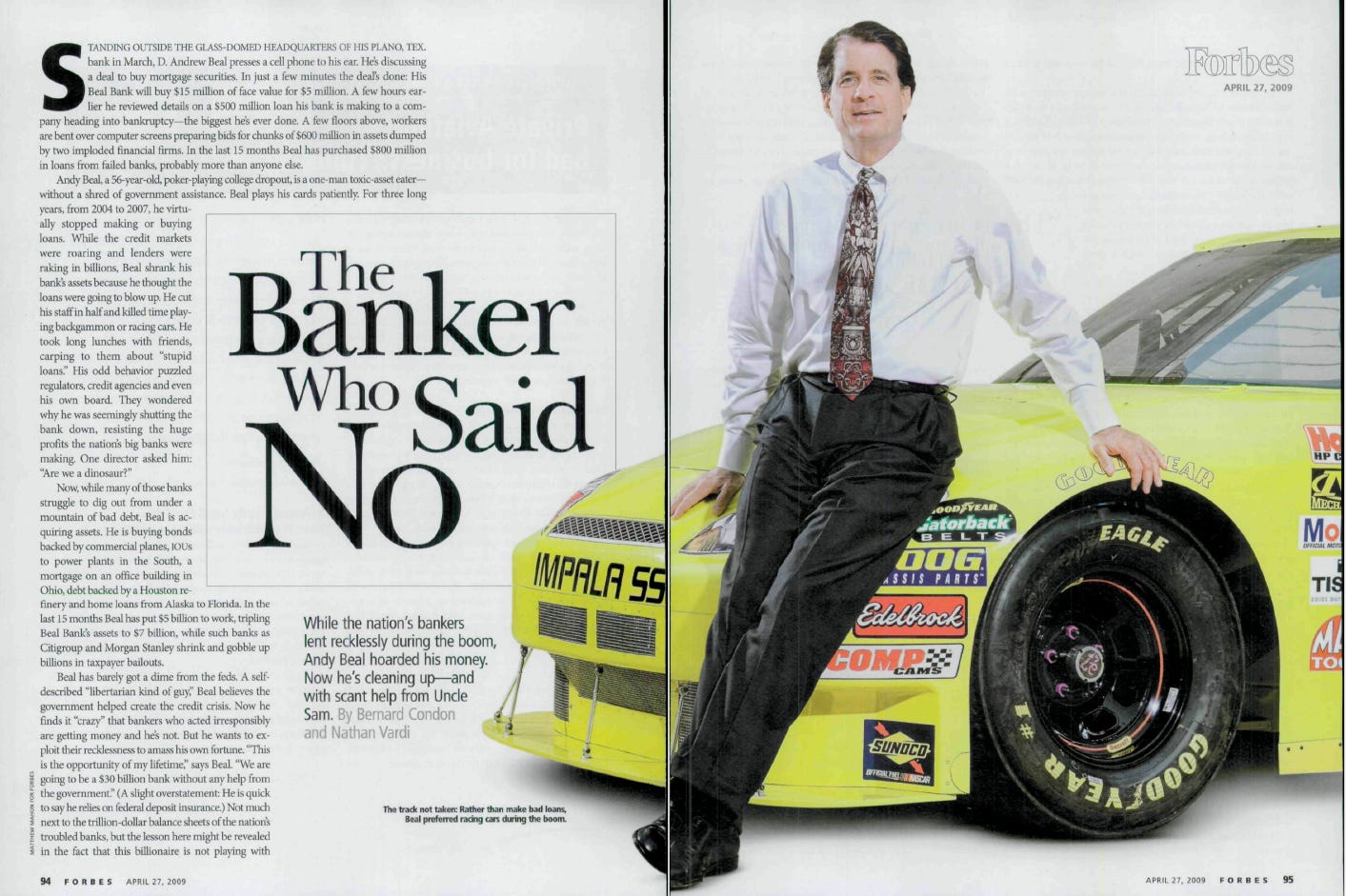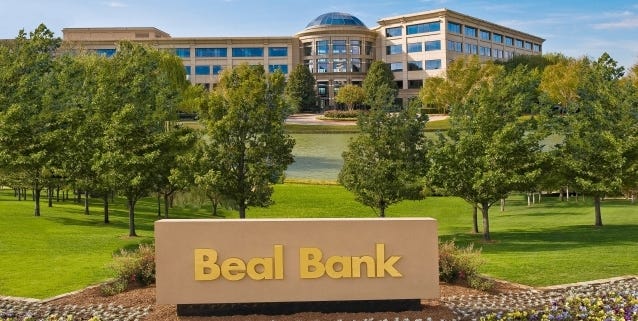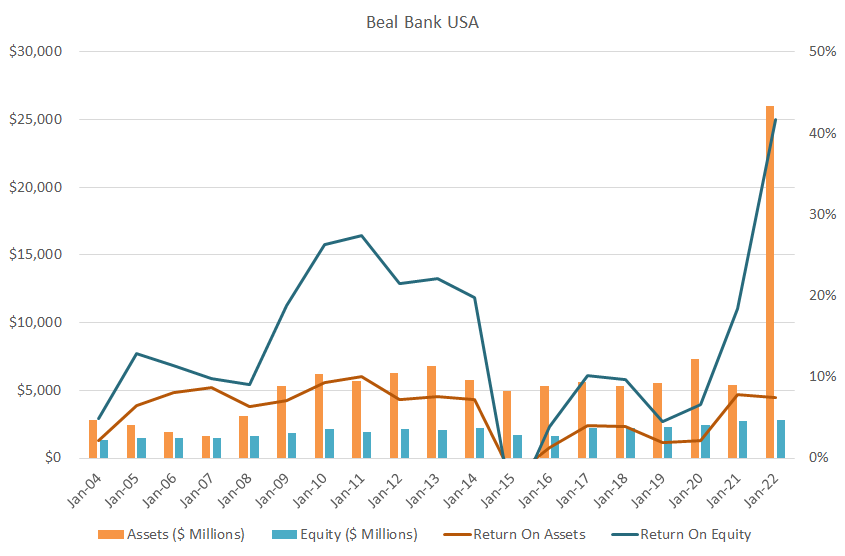High Roller: Lessons from America's Richest Banker
"Why do people not do the great deals and do all the stupid ones? It's crazy." Andrew Beal
“Insurance is not that great a business. It’s a tough game. There are temptations to be stupid. It’s like banking.” — Charlie Munger
“When the music stops, in terms of liquidity, things will be complicated. But as long as the music is playing, you've got to get up and dance.” — Citigroup CEO Chuck Prince in 2007
Even though some industries follow a fairly predictable capital cycle, it seems impossible for their participants to resist the urge to play until it’s too late. Take the mid-2000s in banking. While a few outsiders were sniffing out the big short trade, the insiders were busy trying to get rich while the music was still playing.
All the insiders? No, not all of them.
From 2004 to 2007, Andy Beal did what other bankers could not: he stopped making new loans. His bank’s assets shrunk from $7.7 billion to $2.9 billion.
Beal was “bored stiff”, started coming in late and left early. He took long lunches and spent his time racing cars and playing poker.
He stopped making commercial real estate loans musing that “every deal done since 2004 is just stupid.”
“If I see another office condo in Las Vegas or Phoenix, I'm going to throw up.”
And he started selling loans he had acquired at discounts.
“They were great loans at 85 cents. They're stupid at 115.”
Beal even stopped doing what was considered the safest of banking business, home mortgages guaranteed by Fannie and Freddie. His head of loan purchases recalled salesmen from Countrywide laughing at him when Beal refused to buy securities backed by the government agencies. “Countrywide, Bank of America, Washington Mutual ... every single [mortgage seller] thought we were insane,” he said. “They didn't know why we cared. They thought Fannie and Freddie guarantees were as good as Treasuries.”
They cared because Andy Beal had already figured out that the guarantees were ‘worthless.’
Beal shrank his headcount from 400 to 200 people and tried to rent out half of the space in his headquarters. As his bank seemed to disappear, the credit rating agencies commented he lacked a ‘sustainable business model.’ One of his board members wondered whether they had become ‘a dinosaur’ and bank regulators flat out asked: “What are you doing?”
Beal was undeterred.
Unlike most of his competitors, he had skin in the game.
Beal had built his bank from the ground up, with his own money. And he owned all of it.
If the world wanted to go crazy, it had to do so without him. Beal had always focused on protecting his downside first. He would never, as Buffett put it, “risk losing something that’s very important, to gain something that’s unimportant.”
But he had to be patient.
Beal had expected a credit crunch quickly. “I thought it would end in six months, and sanity would return,” he said. “If I knew it would last nearly four years I would have thought of something else to do.”
For Beal, there was nothing to do but wait.
Wait until the bubble burst, which it eventually did.
Wait until he could scoop up the bargains, which he did.
The Outsider
If people say I'm doing something crazy, that's usually a good sign.
Who is America’s best-known banker? That would be Jamie Dimon.
But who is the richest? That would be Andy Beal, with an estimated net worth of $9 billion.
The son of a mechanical engineer and a secretary grew up in Lansing, Michigan, before settling in Texas. He is best known for showing up in Vegas unannounced to challenge the world’s top poker players, a story told in the book The Professor, the Banker, and the Suicide King. Beal also once poured $200 million into a failed aerospace venture (like Elon Musk he wanted to dramatically lower the cost of launching cargo into space). He even conjured up his own math problem, the Beal Conjecture, and offered a $100,000 prize for its solution.
But the work of his life has been to build America’s most unique bank.
In my second post on Buffett’s alternate history, I wondered if he could have become a banker instead of an insurance tycoon. One of Buffett’s first acquisitions was a bank (which he later had to divest) and he has invested in many public banks since. Like insurance, banking would have offered him leverage. But banking would have severely limited Buffett in his choice of assets to invest in.
Could he have run a bank and invested the way he wanted to? No. But he could still have followed his original principles: focus on finding bargains with downside protection, patiently wait for great opportunities, and magnify the results by using other people’s money (through an investment partnership of float).
And that is the core of Andy Beal’s formula as well.
Beal buys assets when they are unloved or on sale, he lends where others are reluctant to, and he protects downside with diligent work and a focus on collateral. Most importantly, he manages to do nothing when there is nothing to do. Like Buffett in insurance, Beal has demonstrated how to make a fortune in a commodity business.
Let’s break down the high roller’s maxims:
Beal Bank: Think like a hedge fund?
To be a player, you need to build a stake
“All the other banks were failing. What better time to start a bank? If everybody else is going broke, that simply means your competition is going away.”
Play when the odds are in your favor
“You try to lend where capital is scarce. … We do business where no one else wants to. If it's straightforward, it probably isn't for us.”
Always protect your downside first
“I’m not that much of a risk taker. I just take situations that people perceive to be high risk, and I decide that they can be managed to low risk, I’m really very conservative.”
Create the conditions to be disciplined
Stay rational and protect your process
Go all-in when the timing is right (2008, 2022?)
Making a fortune in banking
I am also sharing a list of good sources for anyone interested in further reading at the end.
Beal Bank: Think like a hedge fund?
Beal Bank has occasionally been called ‘an FDIC-insured hedge fund’ and nearly started a fund through an affiliated firm, his commercial loan originator CLG Hedge Fund LLC.
Beal says he put Hedge Fund in the name because he wanted its employees to think like hedge-fund managers, buying and making higher-yielding loans.
Beal wanted his employees to think differently from other banks: he wanted them to think like investors. After the financial crisis, “delinquent loans accounted for 21 percent of all loans” at his Las Vegas-based bank, “compared with an average of 5 percent for all U.S. banks”.
Why did he never operate a hedge fund? He didn’t want the hassle of dealing with outside investors. And he didn’t want to share the upside!
“Interfacing with regulators is one thing. Taking calls constantly from various investors is intolerable. Also, why split profits?”
You know you’ve found a good business when you don’t need to raise outside equity capital and even a 2 and 20 hedge fund fee structure is not attractive enough to share your opportunities.
A big thank you to Icemancapital (substack) who helped me get the FDIC data on Beal’s two banks, the original Beal Bank in Texas and Beal Bank USA in Nevada. We can observe Beal’s strategy in the data: Beal scaled his balance sheets up and down the way a hedge fund adjusts their exposure (well, more slowly).
Notice how:
During booms, total assets shrink and return on assets declines as high yielding loans are paid off.
Assets increase during a recession or distressed cycle as Beal buys discounted portfolios.
Not only does the return on assets increase, return on equity spikes because Beal funds the purchases with deposits, meaning he increases the bank’s leverage (ratio of assets to equity).
After getting paid for hitting the fat pitch, he lets the portfolio run off again.
In 2022, Beal made another play, though this time not on a distressed asset.
Amazingly, he only had one year of net losses, 2015, when Beal Bank USA booked a hefty amount of loan loss provisions.
👉 The remainder of this post and the opportunity to reflect, share, and discuss in the comments are reserved for the community of subscribers. If you would like to support my work and join the conversation, consider subscribing.
Keep reading with a 7-day free trial
Subscribe to Frederik's Age of Alchemy to keep reading this post and get 7 days of free access to the full post archives.







